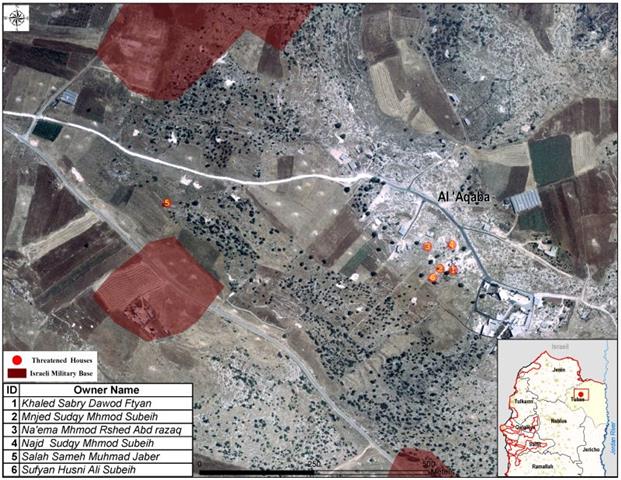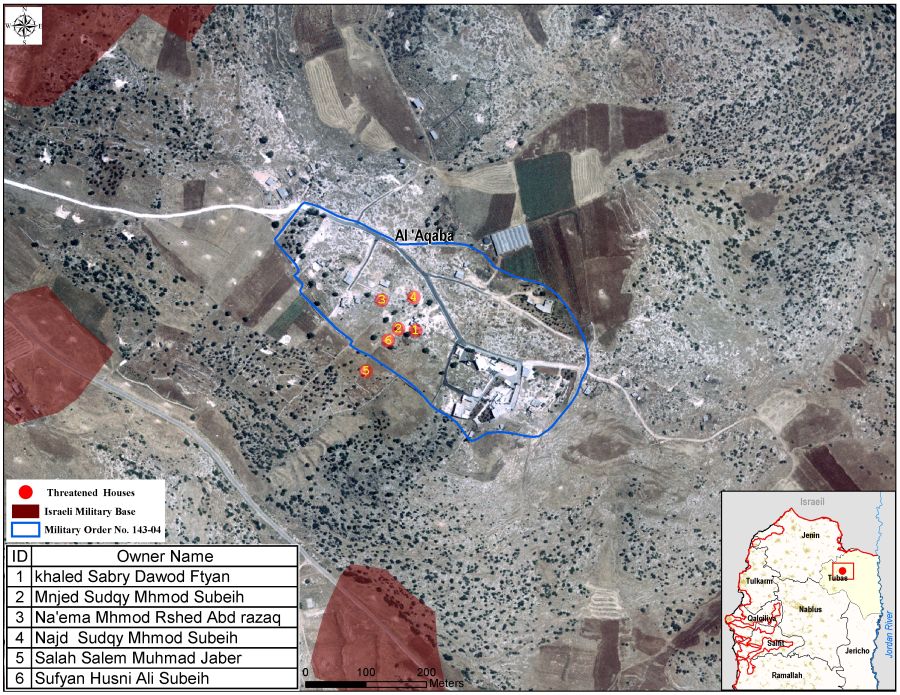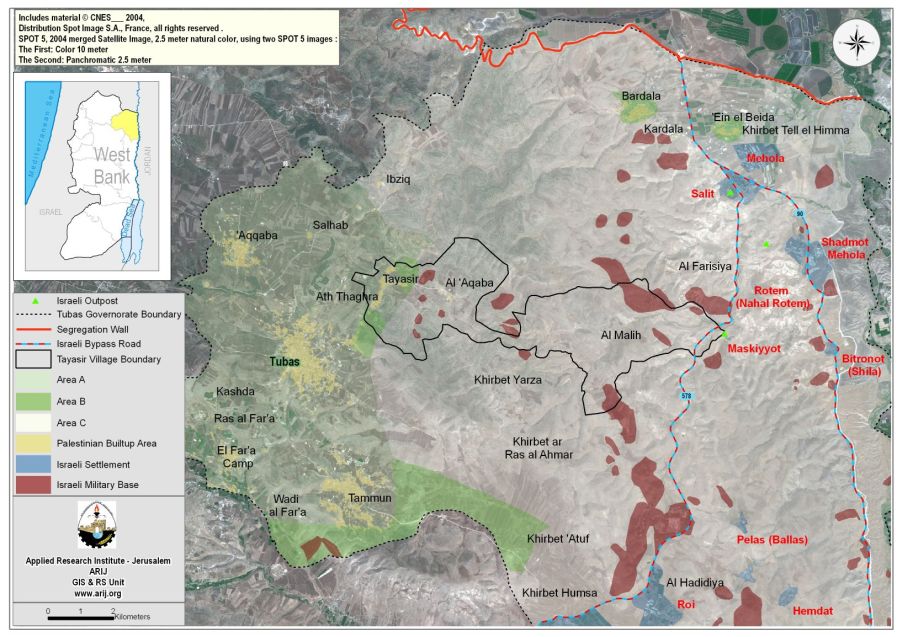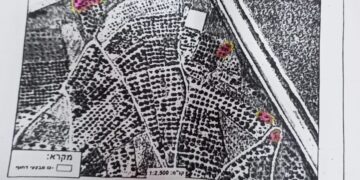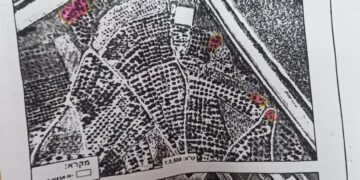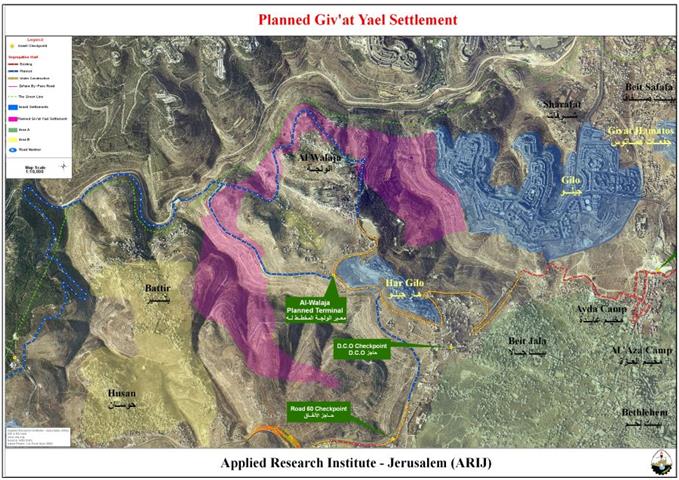On May 8, 2007, the Israeli Occupation Army handed out military notices to six residents from Al-Aqaba village to demolish their residential houses under the pretext of building without licenses. The residents' owners who received demolishing warnings are Sufian Hussny Ali Sbeih, Ni'ma Mahmud Rashid 'Abed El Razeq, Najed Sedqy Mahmud Sbeih, Munjed Sedqy Mahmud Sbeih, Khaled Sabry Da'oud Fetyan, and Salah Salem Mohammad Jabber. See table 1 & map 1 for more details.
Table 1: Details of Israeli Military notices toresidents of Al 'Aqaba
|
Owner's Name
|
Type of structure |
Resident Area in m² |
|
Khaled Sabry Da'oud Fetyan |
House |
453 |
|
Munjed Sedqy Mahmoud Sbeih |
House |
25 |
|
Ni'ma Mahmud Rashid 'Abed El Razeq |
House |
60 |
|
Najed Sedqy Mahmud Sbeih |
House |
80 |
|
Salah Salem Mohammad Jabber |
Agricultural pool |
80 |
|
Sufian Hussny Ali Sbeih |
House |
80 |
The owners of the houses who received the warning notices filed objections against the Israeli Army to stop them from carrying out the demolishing order and currently they are pending court hearings. The Israeli demolishing orders comes in sequence to series of demolishing orders issued by the Israeli Army over the past few years in Al-Aqaba village that has been a target of the Israeli Army for a long time as several military bases of the Army surrounds the village and control the movement of the the residents and accesses to their agricultural lands and other areas in the West Bank including their ability to market their agricultural products.
Previous acts of demolitions in Al-Aqaba village
As mentioned earlier in the case, Al-Aqaba village received dozens of Israeli military orders for houses demolishing with regard to building without proper licensing. During the years period between 2003 – 2006, the residents of Al-Aqaba village received 29 demolition warnings by the Israeli Army to demolish so-called illegal structures built without proper licensing, these demolishing orders targeted; an agricultural pond, a mosque, a kindergarten, the village's warehouse for electrical generator, two cement built rooms and 22 houses, in addition to an order to bulldoze a 500m long by 4m wide newly asphalted road used by the residents of the village to access areas in the West Bank. The residents of Al-Aqaba village and its council filed for injunctions on the Israeli Army's demolishing orders, but were postponed for sometime, still the Israeli Army went with demolishing warnings and actually razed seven houses and destroyed the agricultural pond under the pretext of build without licensing and in close range to the Israeli Army's military bases in that area; as for the remaining demolishing orders they are pending court orders, but the owners and the village council fear that the Army will not wait until the court ruling is out and just carry out their will and demolish the rest of the structures.
Israeli Army annexing 80 % of Al-Aqaba lands
On May 10, 2007, the Israeli Army handed out Al-Aqaba village council a map in which the village boundary is set to a new parameters, which according to Sami Sadeq, head of Al-Aqaba village council, if implemented will take out the majority of the village's lands out of the residents control. Previous acts of the Israeli Army indicate Israel intention to carryout its plans as some 600 residents were forced to leave the village due to the Israeli expansion and annexation policies. Sadeq added that the village will disappear from the map if Israel continue with its plan which is aimed at reshaping the village in accordance to its military needs, which aims at annexing 80 % of it lands. If this map is fully implemented, only six houses will remain inside the new border of the village. In addition, the Israeli army is set to demolish all of the houses that will set out of the village's new boundary, and move the residents to the newly Israeli set boundary of the village; were access to the agricultural lands will become virtually impossible.
The agricultural plane areas, of Tubas governorate and the surrounding villages (including Al-Aqaba village) has been subjected to continuous Israeli violations, that started with Israeli Army's isolating nearly the entire Tubas governorate lands from the West Bank, forcing the residents to live in closed and isolated enclaves in an attempt to push them out of their villages. See Map
Location and Population
Al-Aqaba is a small Palestinian village located on the slope of the Jordan valley from at northeastern side of the West Bank terrains within Tubas governorate. According to the Oslo Accord agreement of September 1995, Al-Aqaba village was classified as area C (that falls under full Israeli administrative and security control. The village has a built-up area of 22 Dunums, with a population 73 inhabitants, PCBS 2006). It is part of the Tayasir villages cluster (23434 Dunums-(Tayasir, Al-Aqaba and Al Malih). The following table 2 list Tayasir villages cluster landuse/ landcover. See Table 2
Table 2: Land Use/ Land Cover Classification within Tayasir villages cluster
| Landuse Landcover 2004 for Al-Aqaba Village Boundary | Area (Dunum) |
| Arable land | 3437 |
| Forests | 253 |
| Heterogeneous agricultural areas | 960 |
| Industrial, commercial and transport unit | 1 |
| Open spaces with little or no vegetation | 4987 |
| Pastures | 654 |
| Permanent crops | 7649 |
| Mine, dump and construction sites | 84 |
| Shrub and/or herbaceous vegetation associations | 3514 |
| Palestinian built-up area | 271 |
| Israeli Military Base | 1624 |
| Total | 23434 |
Source: ARIJ GIS Database 2006
Al-Aqaba village is agriculture in its nature, and the residents dependent on agricultural revenues for their livelihood. after the 1967 war, the Israel Occupation did not recognize Al-Aqaba as a village of its own, instead Israel declared the entire village to be illegal and designated its location as a closed military area.
Israeli Military Bases
The whereabouts of Al-Aqaba village is designated strategic to the Israeli military, which is why several Israeli military bases were established in the areas surrounding the village on an area of 1624Dunums (7%) of Tayasir village's cluster (23434 Dunums ), which caused many problem And obstructions to the Palestinians almost on a daily bases; where the residents are frequently detained and/ or arrested by Israeli troops in the area and have often been prevented from moving on their own land or to move their agricultural products without being harrased by the Israeli Army. Moreover the Israeli bases frequent military training is causing much disturbance to the Palestinian residents and endanger their lives with the live ammunition training and/ or the various explosive devices left behind on the village's lands by the Israeli army that caused injuries to many villagers.
Israeli Bypass Roads
The term bypass road was born with Oslo agreements to designate roads in the occupied Palestinian territory that link Israeli settlements to military camps and/ or to Israel. These bypass roads are strictly restricted to the use of Israeli settlers only and the Army. The Israeli bypass road number 578 stretches a length of 1.224 km to break Tayasir village's cluster, and separates Al-Aqaba village from its agricultural lands. Bypass road # 578: Emerges from Bypass Road number 90, which runs across the Jordan vally area and link the Israeli settlements and the Israeli military bases there together. See map 2
Conclusion
Israel's policy of house demolitions in the Occupied Palestinian Territory seeks to confine Palestinians to small enclaves and separate them from one another and from their agricultural lands and areas set for future development of their built-up areas.
According to the Fourth Geneva Convention Israel as an occupying power is prohibited to demolish Palestinian houses as stated in Article 53 of the Convention which states that: 'Any destruction by the Occupying Power of real or personal property belonging individually or collectively to private persons, or to the State, or to other public authorities, or to social or cooperative organizations, is prohibited, except where such destruction is rendered absolutely necessary by military operations.
Prepared by
The Applied Research Institute – Jerusalem
ARIJ


